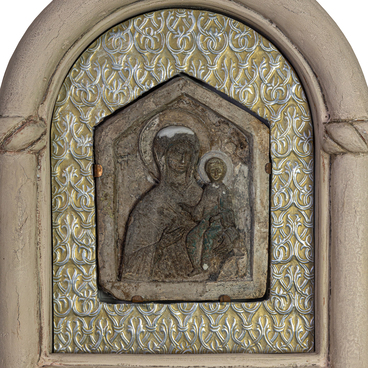The image with a view of the Trinity-St. Sergius Monastery is the oldest known image of the famous monastery today. The original icon was created in the middle of the 17th century, but has not been preserved. It was larger in size — that image, covered with a precious case, adorned the “pritvor” (the extension in front of the entrance” of the new monastery Refectory in 1686-1692. In the documents of the beginning of the 18th century, the icon was called the drawing of the Trinity Monastery.
A copy of this icon is presented in the exhibition of the Sergiev Posad Museum-Reserve. It was created presumably by Kostroma Old Believers in the 19th century. The most revered monastery of the Moscow state is represented in the icon as a sacred space intended for prayer. The main composition is placed on the golden background in a special recess — the “ark” of the icon. It is crowned with the Image of the Life-Giving Trinity, on the sides there is an inscription in gold: “The Monastery of the Holy Life-Giving Trinity of our Reverend Father Abbot Sergius of Radonezh.” The monastery complex is presented in detail. The main structures — temples, bell towers, residential buildings and outbuildings, fortress walls and towers — are accompanied by cinnabar inscriptions. Cinnabar is a paint from the mineral of the same name.
Of particular value are the images of non-preserved buildings, for example, a wooden armory and a stone forge. The icon also depicts the now-lost wooden tsarist palace, built under Ivan the Terrible, but rebuilt after the siege of the monastery.
All structures are reproduced accurately both in terms of topography, and characteristics of their architecture. The the materials of which they are built are accentuated: unbleached or lime mortar bricks, wood; shapes and types of roofing of monastic buildings. The monastery walls and towers with gates are accurately depicted, including the Beer Yard adjacent to the monastery from the west.
There are only three such icons with a view of the Trinity-St. Sergius Monastery of the 17th century. This exhibit was presented to the monastery by Professor Alexander Gorskiy. The icon came to the museum from the monastery in the 1920s.
A copy of this icon is presented in the exhibition of the Sergiev Posad Museum-Reserve. It was created presumably by Kostroma Old Believers in the 19th century. The most revered monastery of the Moscow state is represented in the icon as a sacred space intended for prayer. The main composition is placed on the golden background in a special recess — the “ark” of the icon. It is crowned with the Image of the Life-Giving Trinity, on the sides there is an inscription in gold: “The Monastery of the Holy Life-Giving Trinity of our Reverend Father Abbot Sergius of Radonezh.” The monastery complex is presented in detail. The main structures — temples, bell towers, residential buildings and outbuildings, fortress walls and towers — are accompanied by cinnabar inscriptions. Cinnabar is a paint from the mineral of the same name.
Of particular value are the images of non-preserved buildings, for example, a wooden armory and a stone forge. The icon also depicts the now-lost wooden tsarist palace, built under Ivan the Terrible, but rebuilt after the siege of the monastery.
All structures are reproduced accurately both in terms of topography, and characteristics of their architecture. The the materials of which they are built are accentuated: unbleached or lime mortar bricks, wood; shapes and types of roofing of monastic buildings. The monastery walls and towers with gates are accurately depicted, including the Beer Yard adjacent to the monastery from the west.
There are only three such icons with a view of the Trinity-St. Sergius Monastery of the 17th century. This exhibit was presented to the monastery by Professor Alexander Gorskiy. The icon came to the museum from the monastery in the 1920s.



